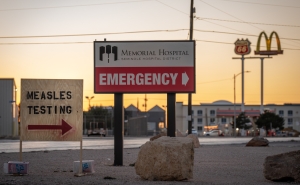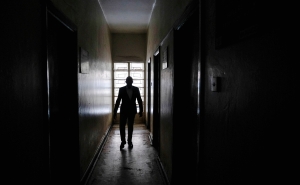A Bleak Winter? Modeling the Next Six Months of COVID, Flu, and RSV
COVID cases are rising. What do the next few months hold?

COVID-19 will still be with us in 2023, but what does that mean in terms of hospitalizations, deaths, and other impacts?
As they’ve done 15 other times during the pandemic, COVID-19 Scenario Modeling Hub research teams have made and shared their projections—this time looking at October 2022 through April 2023.
For Round 16, six participating teams projected what could happen under four scenarios of booster uptake rates and the possibility for new variants with different levels of ability to evade immunity.
In this Q&A, adapted from the December 12 episode of Public Health On Call, infectious disease epidemiologist Shaun Truelove, PhD ’17, MPH, talks with Joshua Sharfstein, MD, about the Modeling Hub’s models for the coming winter and spring. The overriding message: COVID-19 is not over, and we still have to contend with flu and RSV.
Public Health On Call
This article was adapted from the December 12 episode of Public Health On Call Podcast.
What do the latest models look like for COVID?
This time, we were trying to look at some of the new variants that are emerging. We’ve stopped designating them as Greek letters, and now one of the leading ways to designate them is by levels based on the numbers of mutations.
We were looking at what’s called level 5, 6, and 7 variants. Level 5 captures some of the variants people are hearing about like BQ.1, whereas levels 6 and 7 capture variants like BQ1.1, XBB, and some deviants of those. These are characterized by their ability to escape immunity in the population.
What’s protecting us right now is that we’ve developed so much immunity. But new variants are continuing to emerge, so we’re trying to understand what impact these potential immune-escaping characteristics might have coming into the winter season, when we’ve got flu and RSV happening at the same time.
Looking at those variants, along with the impact of boosters—specifically, the new bivalent booster—we are projecting that we will see a fairly large increase in the number of hospitalizations this winter. We’re already starting to see numbers go up quite a bit. We’re not quite out of the woods with this thing.
What are the key factors that you’re looking at to determine whether this could be a bad winter from a COVID perspective?
I think it’s really being driven by these variants. We have a pretty good sense of the vaccine. A couple of new reports have come out, including one from MMWR, showing that the new booster has some advantage compared to the previous monovalent boosters. And of course, just getting a booster in general re-ups your immunity, which we know wanes pretty quickly at this point. But really, it’s these new variants. We’re constantly monitoring them to see which ones are taking over as the dominant strains.
So as the models project variants with more immune escape, you’re predicting more hospitalizations into March and April.
A lot of factors are contributing to what that timeline looks like. I think the March–April timeline is probably less likely. It really depends on how much infection occurs this winter. If a lot of people get infected in the next month or two, we’re going to be less likely to see something in the spring, and currently we are seeing quite a bit of rise. There are certain states where it’s even more pronounced—California is seeing a really rapid rise right now. They are currently at the number of hospitalizations they saw this summer when the BA.4 and BA.5 variants were taking over, and they are still rising. That might be a picture of what’s to come in other states as well.
What about the flu situation?
We are projecting a pretty substantial flu season. Right now, hospitalizations are tracking pretty well with our most pessimistic scenario, which is defined by the fact that there is very little immunity in the population because we haven’t been infected in the last couple of years. Our projections are a much earlier season, which we already know is happening, and a much larger season than we’re used to seeing. In our previous worst season, we experienced somewhere around 37,000 hospitalizations in the peak week. We’re expecting it to be substantially larger—up to about 46,000 to 50,000, with the potential for even larger numbers.
I remember when the flu alone could tip over the health care system.
And the combination of the COVID and flu is daunting. We ran the numbers and combined them from our projection rounds, and we’re seeing potentials of 60,000–70,000 hospitalizations in the peak week toward the end of December.
What about RSV?
The good news with RSV is that it looks like it’s trending down already. It seems to have had its season a bit earlier than the other two viruses, so hopefully there won’t be a synchronization of peaks, which is the scary thing that I think is starting to happen with COVID and flu.
But, different populations are affected. COVID is not affecting the pediatric population nearly to the extent that RSV or flu is, and RSV doesn’t generally send many adults to the hospital, so that’s good news. But we’re still seeing pediatric hospitals overwhelmed right now, so I think we’re going to have a lot of tired health care workers and parents as well.
It sounds like there’s every reason to get the new booster and a flu shot if you haven’t yet.
Absolutely. They’re our best protection. And the reports on flu vaccine effectiveness are really good—this is one of the best flu vaccines we’ve seen in years. As I said earlier, the bivalent COVID-19 booster shows good improvement over the previous booster.
We know that getting a booster re-ups your antibodies and your immunity. Even if it doesn’t prevent you from getting infected, it’s going to keep you from having a serious illness, or even an annoying one where you’re out of work, tired, and not feeling well.
Joshua Sharfstein, MD, is the vice dean for Public Health Practice and Community Engagement and a professor in Health Policy and Management at the Johns Hopkins Bloomberg School of Public Health. He is also the director of the Bloomberg American Health Initiative and a host of the Public Health On Call podcast.





